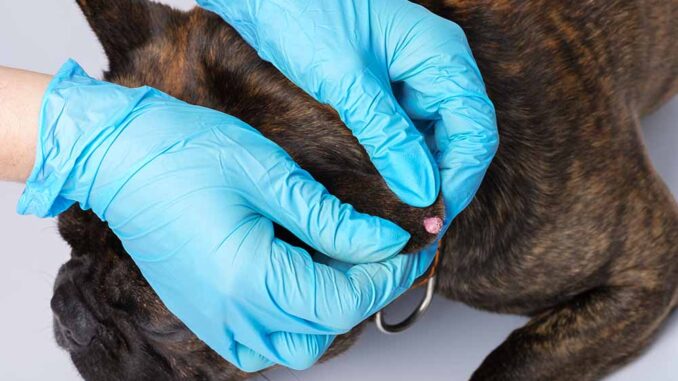
This article was updated on October 15th, 2023
Of the many lumps and bumps that can pop up on a dog’s skin, sebaceous adenomas are one of the most common. Fortunately, they’re also one of the least likely to cause a serious issue. That’s because they are non-cancerous and usually don’t cause your dog even a second thought, let alone discomfort.
What are sebaceous adenomas?
Sebaceous adenomas, also known as sebaceous gland tumors, are benign tumors that can occur in dogs. These tumors originate from the sebaceous glands, which are oil-producing glands located in the skin. These glands are more heavily concentrated on the paws, neck, chin, face, rump, and tail and help to keep the skin and hair moist, soft, and even ward off bacteria.
Sebaceous adenomas are relatively common in senior dogs and are more frequently seen in certain breeds, such as Cocker Spaniels, Beagles, and Poodles. The exact cause of sebaceous adenomas is unknown but it’s suspected to have a genetic component since they occur more frequently in some breeds. Sebaceous adenomas are also more common with age.
What do sebaceous adenomas on dogs look like?
These tumors typically appear as small, raised, and well-defined growths on the skin. They can vary in size and may be solitary or multiple. Sebaceous adenomas often have a wart-like or cauliflower-like appearance consisting of many bumps or lobes. Colors can range anywhere from pink to brown. They usually grow slowly and may remain stable in size or gradually increase over time. These growths tend to grow outward on to the skin surface. They are narrower at the base and are often on a thin stalk. Sebaceous adenomas are commonly confused with warts.
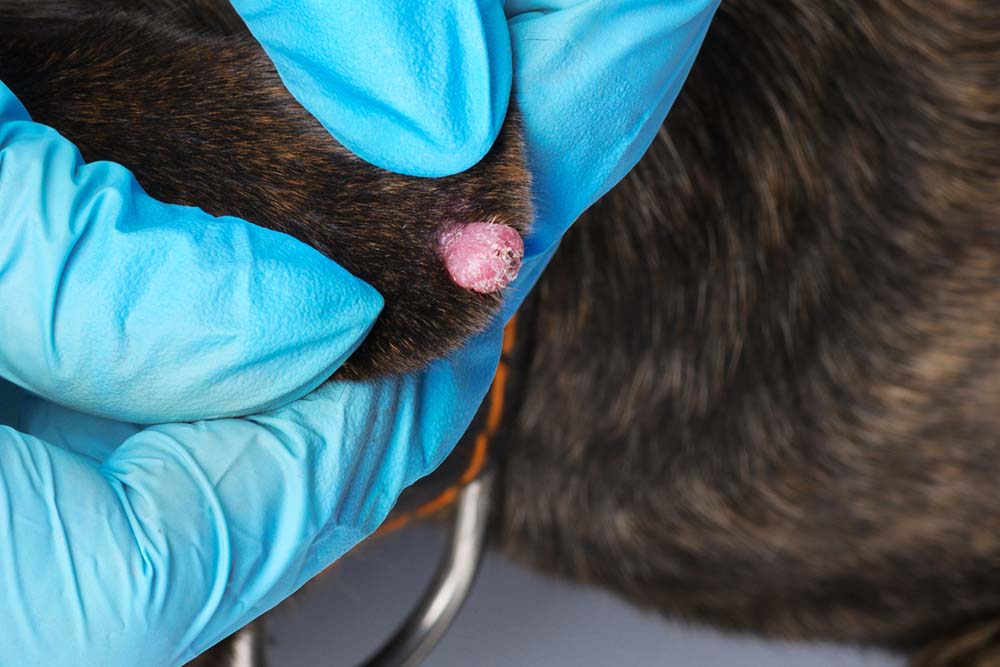
The growths are usually 4mm to 10mm in size and sometimes they might extend below the surface of the skin.
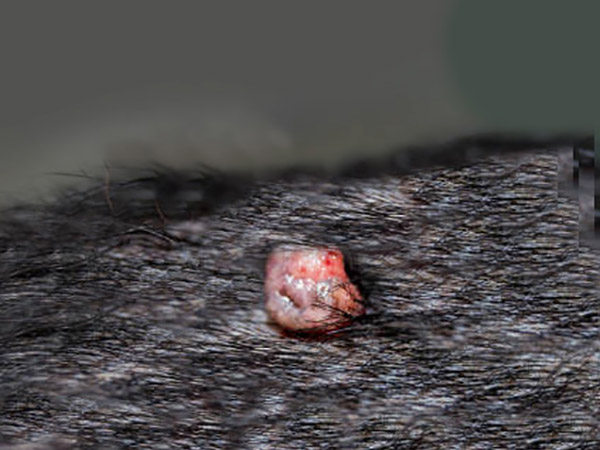
Since sebaceous adenomas originate from the sebaceous glands, they can be found anywhere on the skin. However, they do tend to appear more commonly on the face, feet, and legs. Pictured below is a sebaceous adenoma on a dog’s face.
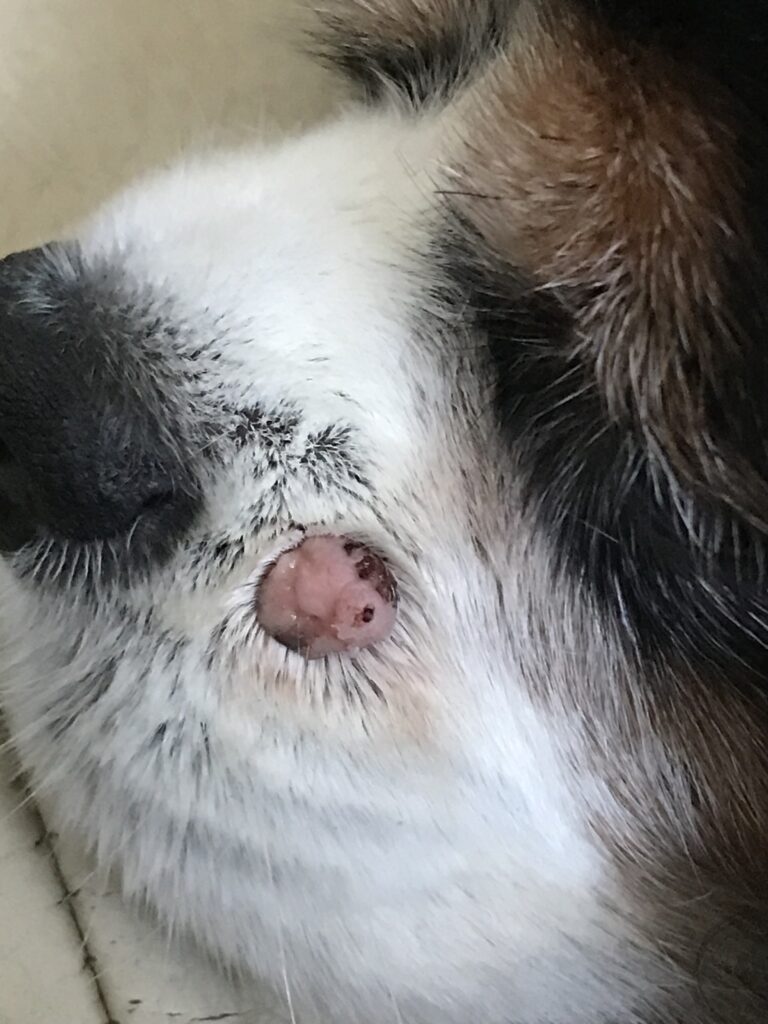
Clinical signs
Noticing one or more of these small bumps on your dog’s skin may be the only thing you see. Most of the time dogs aren’t really bothered by sebaceous adenomas, unless they pop up in a place that can cause rubbing (like the armpit) or pressure (like the chest). Instead, you’re more likely to find sebaceous adenomas when you’re petting your dog or they are reported by your groomer.
So, that’s most of the time. Occassionally, sebaceaous adenomas can ooze or weep a thick, oily material. Other times, they cause your dog some discomfort, leading them to lick or chew on the lump. If this is the case, the lump may become reddened or bleed. They can even become infected, potentially creating a foul smelling ooze and swelling.
Is there anything I can do at home to help my dog?
The good news is most sebaceous adenomas aren’t going to affect your dog, so there’s really nothing for you to do about them. About the only thing required of you is to be diligent about checking your dog for lumps and bumps, including new sebaceous adenomas. You will also want to monitor the size, shape, and color and see your veterinarian any time a new bump pops up or an existing bumps changes.
If your dog starts to chew or scratch at one of their previously diagnosed sebaceous adenomas, you may decide to apply a light wrap or to wash it with a warm washcloth to keep it from oozing all over your house.
How will a vet handle sebaceous adenomas in dogs?
It’s always best to see your vet whenever your pup shows up with a new lump or bump on their skin. This is just to get a proper diagnosis and to do any treatment while the lump is still small and new.
Diagnosis
Most sebaceous adenomas can be diagnosed just by looking at them, but your vet will more than likely take a biopsy or small sample with a needle to look at under a microscope. When they make that diagnosis of sebaceous adenoma, they will then discuss with you whether you think treatment is necessary.
Treatment
The vast majority of sebaceous adenomas don’t need any treatment. They aren’t cancerous so they won’t cause any real damage. That being said, some sebaceous adenomas can bother a dog causing them to lick or chew. This creates irritation that can lead to inflammation and infection. If this is the case, these sebaceous adenomas should be removed. The prognosis is usually good. Be aware that removing one sebaceous adenoma will cure that lump, but it won’t prevent others from showing up, something that is common as a dog ages.
Sometimes, sebaceous adenomas can be more invasive. These are sebaceous adenocarcinomas, and removal is indicated.
What is the process to remove sebaceous adenomas?
Depending on the size or number of sebaceous adenomas your vet is going to remove, they may use general anesthesia or sedation and local anesthetic. For one or two small ones, sedation and local will work great. The sebeceous gland along with the lump will be removed and then the incision will be closed with a stitch or glue.
For larger or multiple lump removal, your vet may opt for anesthesia. The lumps will be removed and closed. Cautery may come in handy for the larger ones.
What is the cost of removal?
This is one of the less expensive lumps to remove and most will pay around $200-$300. If your dog is having multiple sebaceous adenomas removed or if they’re in a challenging place, like the face, that cost may increase.
FAQ
Are sebaceous adenomas painful to dogs?
Most sebaceous adenomas don’t cause dogs any discomfort. They will barely even know they are there. However, if they show up in areas where they may rub, like the armpit, they can become uncomfortable.
Do sebaceous adenoma go away or keep growing over time?
Sebeceous adenomas don’t go away without removal but they are slow growing lumps. Some will reach a mature size and stay there, while some will continue to grow very slowly over time.
If we do not remove it, is there anything we need to be careful about?
The majority of sebaceous adenomas aren’t removed and the dogs are just fine. However, some can become irritated or inflammed, especially if your dog starts to bother it and so infection may become an issue. Regular monitoring will help prevent this.
Can sebaceous adenoma dog rupture? What happens then?
Sebaceous adenomas can bleed or become ulcerated if a dog is excessively licking, scratching, or chewing on them. This does increase the chance of infection, so these bumps are best if removed.
Will sebaceous adenomas grow over time?
Sebaceous adenomas are very slow growing and may increase in size over time. It’s best to monitor them for any chances in color, shape, or rapid increase in size and report these changes to your vet.
If my dog has a sebaceous adenomas, is my dog more at risk of developing more of them?
Dogs tend to get more sebaceous adenomas as they age.
What’s the difference between a sebaceous adenoma and a sebaceous cyst?
A sebaceous adenoma is an abnormal proliferation of the sebaceous cells that make up the gland. A sebaceous cyst is most often a sebaceous gland that becomes clogged or has some trauma that causes a small sac to grow inside the sebaceous gland. Learn more about sebaceous cysts in dogs.
What’s the difference between a sebaceous adenoma and a dog wart?
Dog warts and sebaceous adenomas look very similar and are often confused for one another. However, the difference is that dog warts are growths caused by the papilloma virus and sebeceous adenomas don’t have a viral component. Learn more about dog warts.
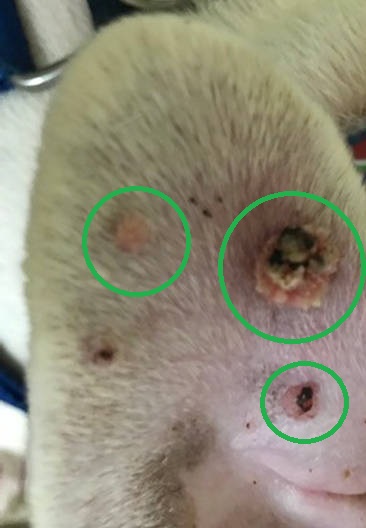
Disclaimer: This website's content is not a substitute for veterinary care. Always consult with your veterinarian for healthcare decisions. Read More.


Be the first to comment